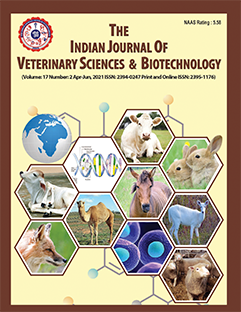Diagnosis of Horn Cancer through Thermography and It’s Surgical Management in Cattle
DOI:
https://doi.org/10.48165/ijvsbt.21.6.07Keywords:
Cattle, Histopathology, Horn cancer, Surgical management, ThermographyAbstract
Horn cancer is one of the most prevalent cancers among all neoplastic conditions impacting the bovine population and productivity. A reduction in draught performance, milk production and general well-being leads to considerable economic loss to the farmers. The present study was aimed to diagnose horn cancer early through thermography and its timely surgical management in cattle. The present study involved 34 cases of first-degree horn cancer in bullocks (31/34) and cows (3/34) presented at the Veterinary College Clinic in Junagadh (Gujarat, India) and the area around Junagadh during the year 2024. The study revealed the highest incidence of horn cancer in Gir and Kankrej cattle (47.06% each) predominantly affecting castrated male animals (91.18%). In cases with first-degree horn cancer, shaking of the head, rubbing of the horn on hard objects, nasal discharge from the affected side of horn and lachrymation were the predominant clinical signs. The most affected age group was 6-10 years (52.94%) and the left horn was more frequently involved (67.65%). All the animals passed through thermography showed consistent higher temperature in affected than non-affected horns, proving it a reliable non-invasive diagnostic tool. This was followed by surgical amputation of affected horn and histopathological confirmation, which identified squamous cell carcinoma (6 cases) and other conditions like papilloma, dysplastic changes, myxomatous growths and normal horn tissue without pathological changes.
Downloads
References
Bamne, S.S., Londhe, S.P., Moregaonkar, S.D., Yadav, G.U., Yerolkar, A.J., & Khangal, P.S. (2007). Horn cancer in a non-descript cow – A case report. Intas Polivet, 8(1), 178–179.
Casas-Alvarado, A., Martinez-Burnes, J., Mora-Medina, P., Hernandez-Avalos, I., Dominguez-Oliva, A., Lezama-Garcia, K., & Mota-Rojas, D. (2022). Thermal and circulatory changes in diverse body regions in dogs and cats evaluated by infrared thermography. Animals, 12(6), 01–18.
Chauhan, J.M. (2019). Studies on proliferation biomarkers in squamous cell carcinoma of bullock horn by immunohistochemistry and its correlation with histopathology. M.V.Sc. Thesis. Junagadh Agricultural University, Junagadh, Gujarat, India.
D’Alessandro, G., Tavakolian, P., & Sfarra, S. (2024). A review of techniques and bio-heat transfer models supporting infrared thermal imaging for diagnosis of malignancy. Applied Science, 14(4), 01–32.
Eddy, A.L., Van Hoogmoed, L.M., & Snyder, J.R. (2001). The role of thermography in the management of equine lameness. The Veterinary Journal, 162(3), 172–181.
Gholve, D.T. (2002). Epidemiological and histopathological study of bovine squamous cell carcinoma with special reference to horn and eye cancers. M.V.Sc. Thesis. Konkan Krishi Vidyapeeth, Dapoli, Maharashtra, India.
Hovinen, M., Siivonen, J., Taponen, S., Hänninen, L., Pastell, M., Aisla, A.M., & Pyorala, S. (2008). Detection of clinical mastitis with the help of a thermal camera. Journal of Dairy Science, 91(12), 4592–4598.
Jaiswal, S., Singh, H.N., Kumar, S., & Jadon, N.S. (2014). Horn cancer: A clinical insight into its diagnosis and management in 10 cattle. Intas Polivet, 15(1), 3–5.
Joshi, B.P. (1983). The study of bovine neoplasm in Gujarat state with special reference to cancer of horn. M.V.Sc. Thesis. Gujarat Agricultural University, Anand, Gujarat, India.
Joshi, B.P., Soni, P.B., Fefar, D.T., Ghodasara, D.J., & Prajapati, K.S. (2009). Epidemiological and pathological aspects of horn cancer in cattle of Gujarat. Indian Journal of Field Veterinarian, 5(2), 65–67.
Kaul, P.L., & Kalra, D.S. (1973). Incidence of horn cancer in Haryana State. Haryana Agricultural University Journal of Research, 3(3), 161–165.
Kunc, P., Knizkova, I., Prikryl, M., & Maloun, J. (2007). Infrared thermography as a tool to study the milking process: A review. Agriculture in Tropics and Subtropics, 40(1), 29–32.
Luna, L.G. (1968). Manual of Histologic Staining Methods of the Armed Forces Institute of Pathology. Armed Forces Institute of Pathology, Washington, D.C., pp. 258.
Mahla, J.K., Anjana, R.R., Parikh, P.V., Parmar, J.J., Koli, P., Patel, M.D., & Mecvan, A.R. (2021). Surgical management of horn affections in large ruminants. Ruminants Science, 2(10), 475–478.
Naik, S.N., Balakrishnan, C.R., & Randelia, H.P. (1969). Epidemiology of horn cancer in Indian Zebu cattle: Breed incidence. British Veterinary Journal, 125(5), 222–230.
Panchal, J.H., Bhatt, R.H., Raval, R.J., Kalaria, V.A., & Vadalia, J.V. (2024). Diagnosis and surgico-therapeutic management of bovine tumours. The Indian Journal of Veterinary Sciences & Biotechnology, 20(1), 70–76.
Pavelski, M., Silva, D.M., Leite, N.C., Junior, D.A., De Sousa, R.S., Guerios, S.D., & Dornbusch, P.T. (2015). Infrared thermography in dogs with mammary tumors and healthy dogs. Journal of Veterinary Internal Medicine, 29(6), 1578–1583.
Prajapati, K.S., Heranjal, D.D., Gangopadhyay, R.M., Jani, B.M., & Sukumaran, K. (1987). Pathological studies on bovine horn cancer with particular reference to the site of origin. Indian Journal of Animal Sciences, 58, 900–905.
Purohit, R.C., & McCoy, M.D. (1980). Thermography in the diagnosis of inflammatory processes in the horse. American Journal of Veterinary Research, 41(8), 1167–1174.
Rokad, H.A. (2022). Clinical studies of diagnosis and surgico chemotherapeutic management of mammary gland tumours in dogs. M.V.Sc. Thesis. Kamdhenu University, Junagadh, Gujarat, India.
Singh, D., & Singh, A.K. (2020). Role of image thermography in early breast cancer detection - past, present and future. Computer Methods and Programs in Biomedicals, 183, 105074.
Singh, S., & Singh, G. (2005). Important aspects of horn cancer. The Indian Cow, 2(6), 32–39.
Soni, P.B. (2007). P53 gene scanning in healthy and affected tissue of horn cancer suffering cattle (Bos indicus). M.V.Sc. Thesis. Anand Agricultural University, Anand, Gujarat, India.
Turner, T.A. (1991). Thermography as an aid to the clinical lameness evaluation. Veterinary Clinics of North America: Equine Practice, 7(2), 311–338.
Udharwar, S.V. (2004). Studies on incidence, symptomatology and treatment of horn cancer with special reference to anticancer drugs. M.V.Sc. Thesis. Maharashtra Animal and Fishery Sciences University, Nagpur, Maharashtra, India.
Downloads
Published
Issue
Section
License
Copyright (c) 2025 Indian Journal of Veterinary Sciences and Biotechnology

This work is licensed under a Creative Commons Attribution-NonCommercial-NoDerivatives 4.0 International License.




